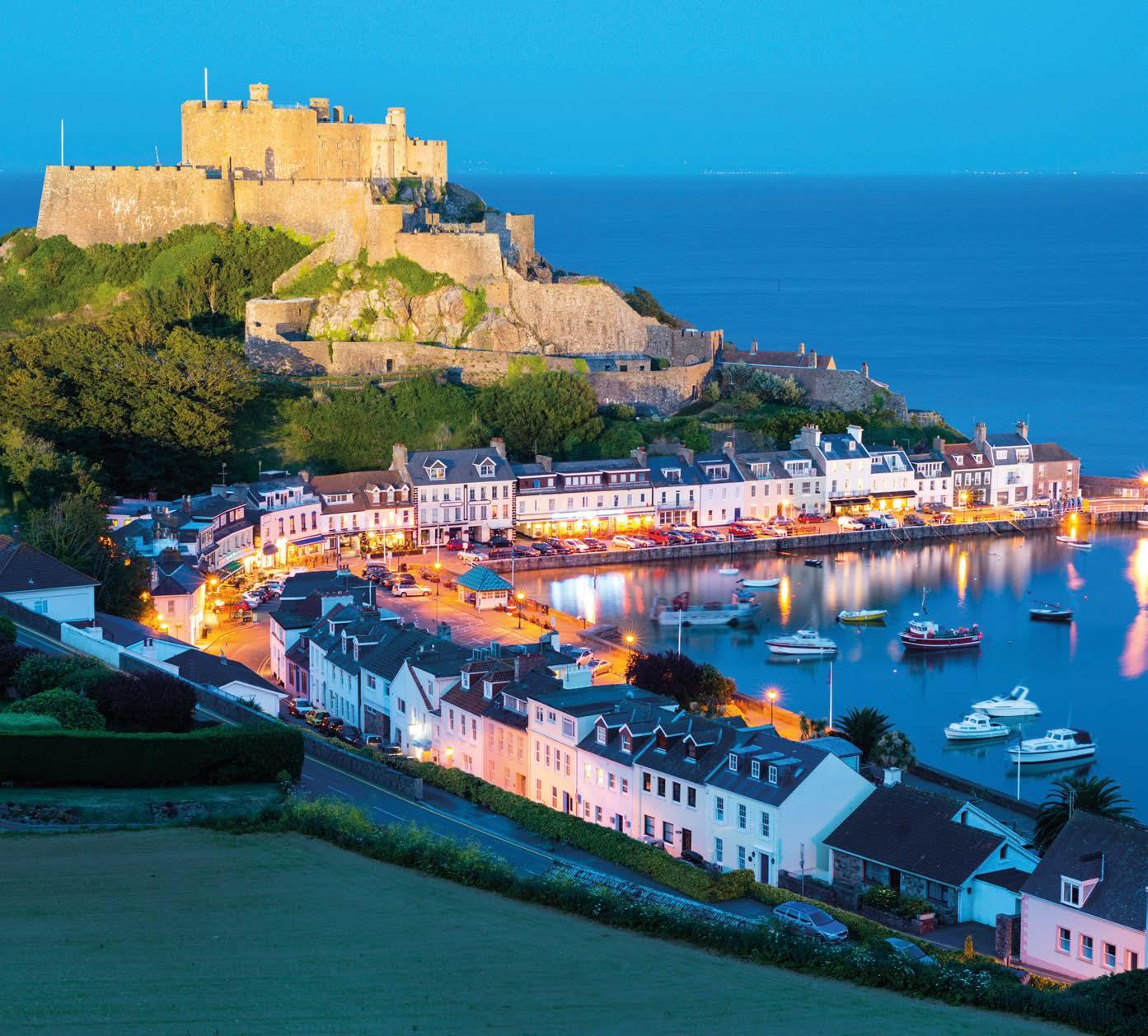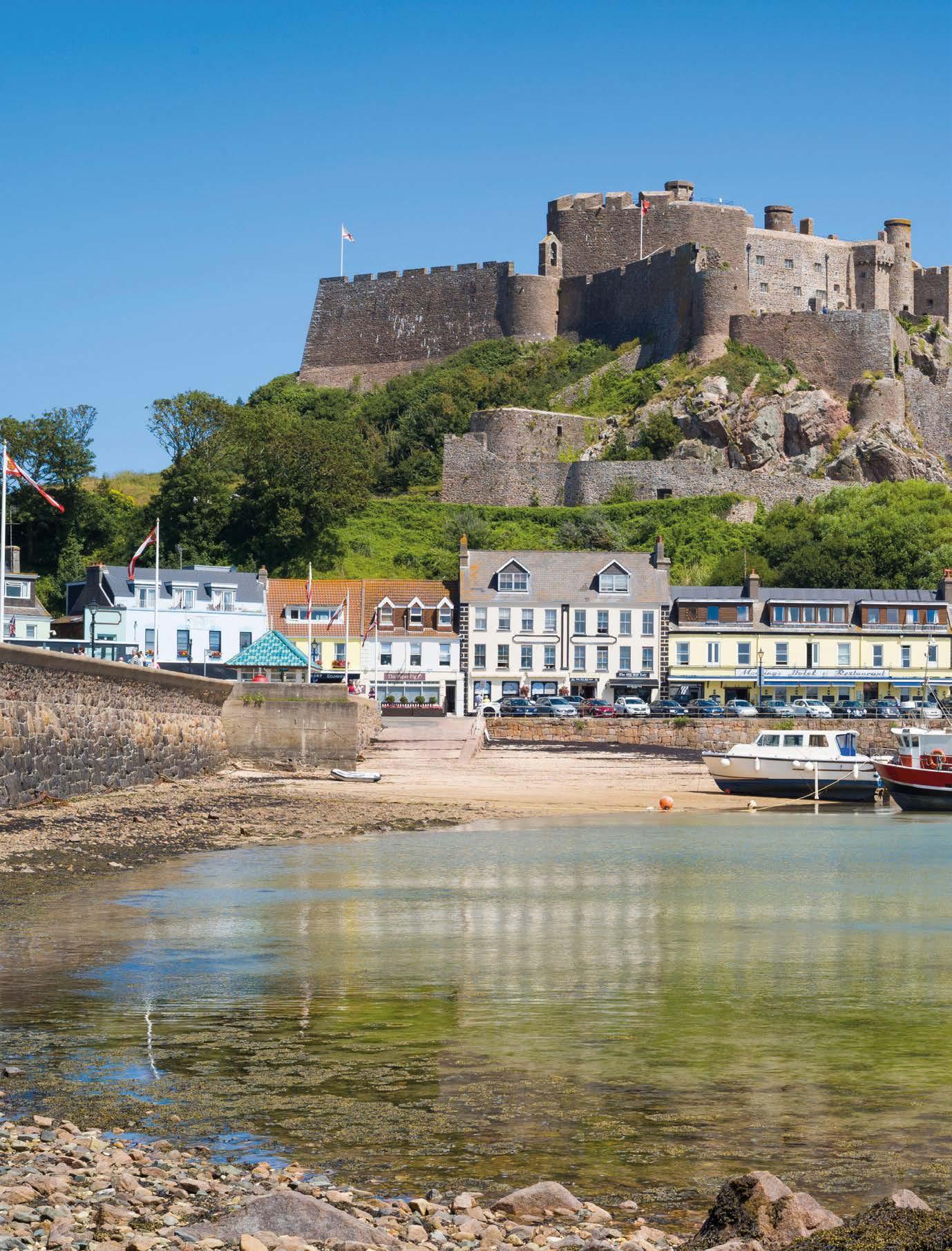Story of an island

A unique blend of English and French influences, the fascinating island of Jersey is a delight for history buffs
WORDS NATASHA FOGES

BRITAIN 15 www.britain-magazine.com
CHANGING THE GUARD
Foot Guards from the Household Division marching in their red tunics and bearskin hats for the Changing of the Guard at Buckingham Palace is a must-see for any visitor to London. Household Troops have guarded the sovereign and royal palaces since 1660 and today’s iconic ceremony, also known as Guard Mounting, usually takes place every Monday, Wednesday, Friday and Sunday.
Get an early spot at Buckingham Palace gates or on the steps of the Victoria Memorial to watch: the Old Guard form in the palace’s forecourt from 10.30am, joined by the Old Guard from nearby St James’s Palace, before the New Guard marches up from Wellington Barracks to take over responsibilities. householddivision.org.uk
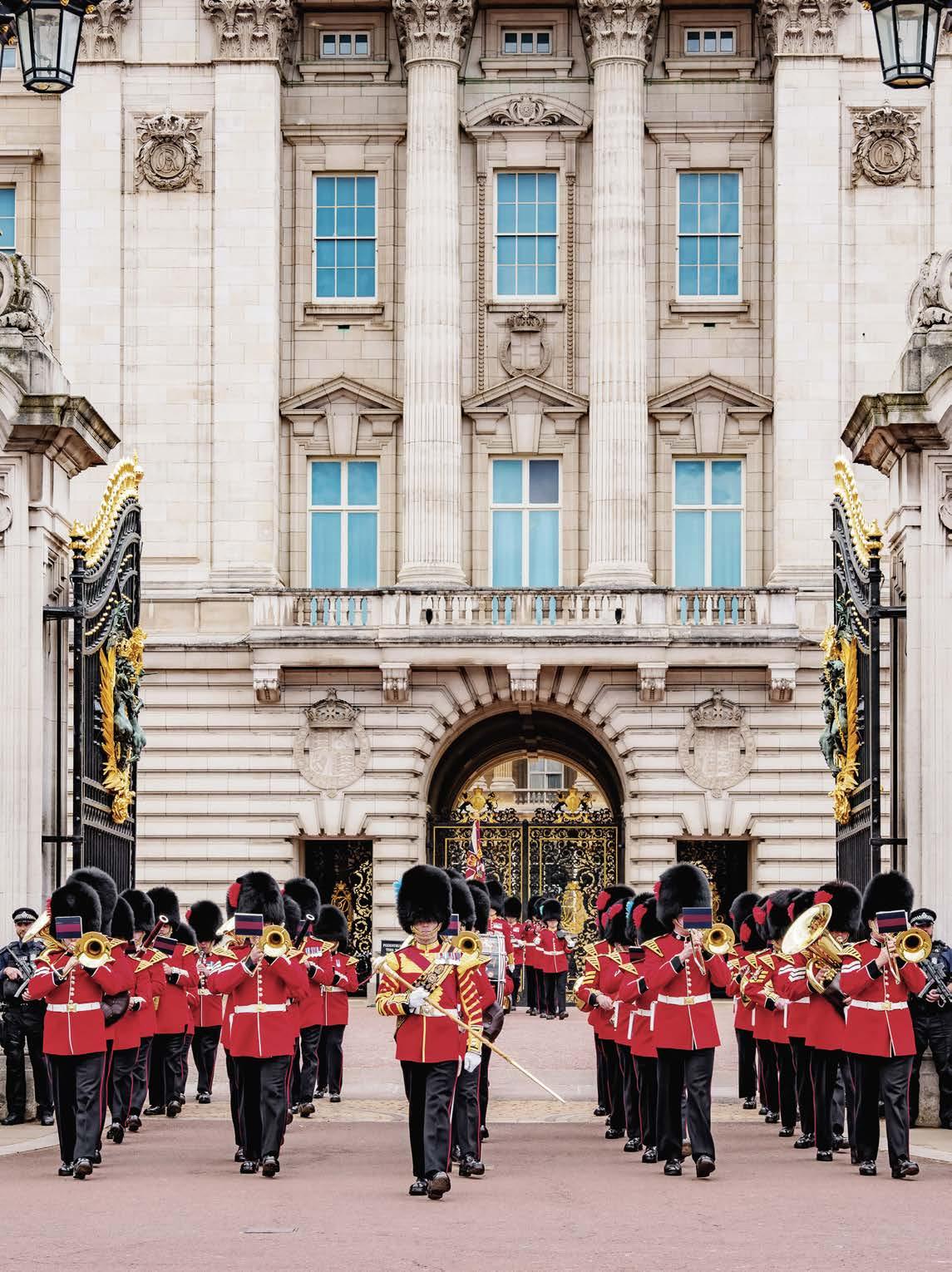
26 BRITAIN www.britain-magazine.com PHOTOS: © KAROL KOZLOWSKI/AWL IMAGES /HISTORIC ROYAL PALACES/RICHARD LEA-HAIR/ANDY SILLETT/ALAMY traditions
TOWER OF LONDON CEREMONIES

THE LORD MAYOR’S SHOW
“The oldest, longest, best-loved and least-rehearsed civic procession in the world”, the Lord Mayor’s Show is a reminder of the city’s longstanding independent spirit. In the 13th century King John, struggling to control the country, tried to keep Londoners on side by allowing the city special powers, including the annual election of its own mayor in place of a royal-appointed sheriff. Each new mayor journeyed to Westminster to swear loyalty to the monarch: giving rise to today’s flamboyant show, on the second Saturday in November.
The huge procession – livery companies, bands, charities, businesses, HM forces, the Lord Mayor in the dazzling State Coach – wends from Mansion House to the Royal Courts of Justice where the oath of allegiance is sworn, before returning via the Embankment. Check the published itinerary for top vantage points. lordmayorsshow.london
The centuries-old Ceremony of the Keys, when the Chief Yeoman Warder is escorted to lock the gates at the Tower of London at 9.53pm precisely, has become a hot-ticket event. But the Tower has also accumulated numerous less-well-known rituals over the years, such as the Constable’s Dues. In days gone by the Constable of the Tower enjoyed a variety of perks, not least a portion of the cargoes (ranging from oysters to wine) of ships that had to moor off Tower Wharf when they came upstream to the City. To this day, the captain of any Royal Naval vessel that moors on the wharf ceremoniously presents the Constable with a barrel of wine –which is duly opened and quaffed. hrp.org.uk

BRITAIN 27 www.britain-magazine.com traditions

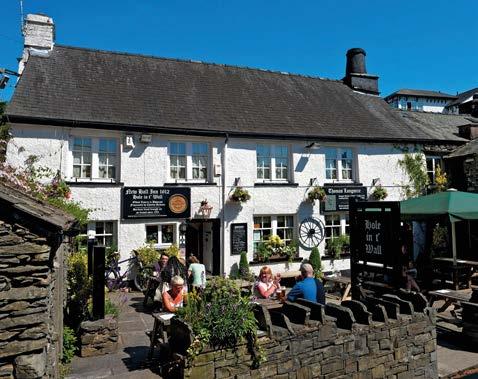

On each visit to the Lake District, my curiosity about this hallowed landscape so eulogized by the poets – “the loveliest spot that man hath ever found”, said William Wordsworth – has been piqued. How, though, to see it all, not as a serious climber, but as an “average Joe” walker interested in Wordsworth’s “sublime” scenery, the villages and towns, as well as the people, along the way?
I consulted a series of Ordnance Survey maps. There were 1,342 miles of public footpaths and 544 miles of bridleways to explore across 912 square miles of land (the national park is 32 miles across and 40 miles from north to south). I read a large number of books, Wordsworth’s included. I plotted a vague route: a big wobbly circle taking in all 16 main lakes, which would form the focus of the hike, and some of the principal mountains. I bought a train ticket to Penrith.
With a month free, a backpack and a spring in my step, off I went. It was early April. Snow was still on the peaks and, as I crossed beneath the M6 motorway from Penrith, the madness of a population of 67 million squeezed into a small place (Britain) seemed to peel away. Tension lifted in my shoulders. Worries seemed to fade. The sound of
traffic eased as the path led through farmland of sheep and cattle.
All alone, I got my first glimpse of lake. Ahead, a mere hour or so from Penrith, was Ullswater – “the happiest combination of beauty and grandeur which any of the lakes affords”, said Wordsworth. And who was I to disagree?
From the village of Pooley Bridge, with boulders and driftwood scattered by the shore, a vast luminous pool of gently swelling water reflected the soft-blue sky and little cotton-bud clouds. On the horizon, russet-green fells capped with snow tumbled into the distance like hidden Himalayas. I was quite blown away by the “beauty and grandeur”, too.
There are tried and tested ways of seeing the Lake District, the most usual being to clamber up the 214 fells (mountains) listed in the delightful pictorial guides penned by Alfred Wainwright (1907-91). Turn up in your car and scamper to the top of a couple, probably including Scafell Pike, at 978 metres England’s highest summit. Or else systematically tick off Wainwrights (as his favourite mountains are called): “bag” them, as the mountain-climbing terminology goes.
Nothing wrong with that. I just didn’t want to do it

34 BRITAIN www.britain-magazine.com landscapes
© PURPLE MARBLES
PHOTOS:
CUMBRIA/JOHN EVESON/IAN G DAGNALL/ALAMY/TOM CHESSHYRE
Previous page: The pretty hamlet of Hartsop in the Patterdale Valley This page, clockwise from top left: Tom Chesshyre at The Old Man of Coniston; Glenridding Pier, Ullswater; St Patrick's Church in Patterdale; The Hole in t'Wall pub on Windermere dates back to 1612
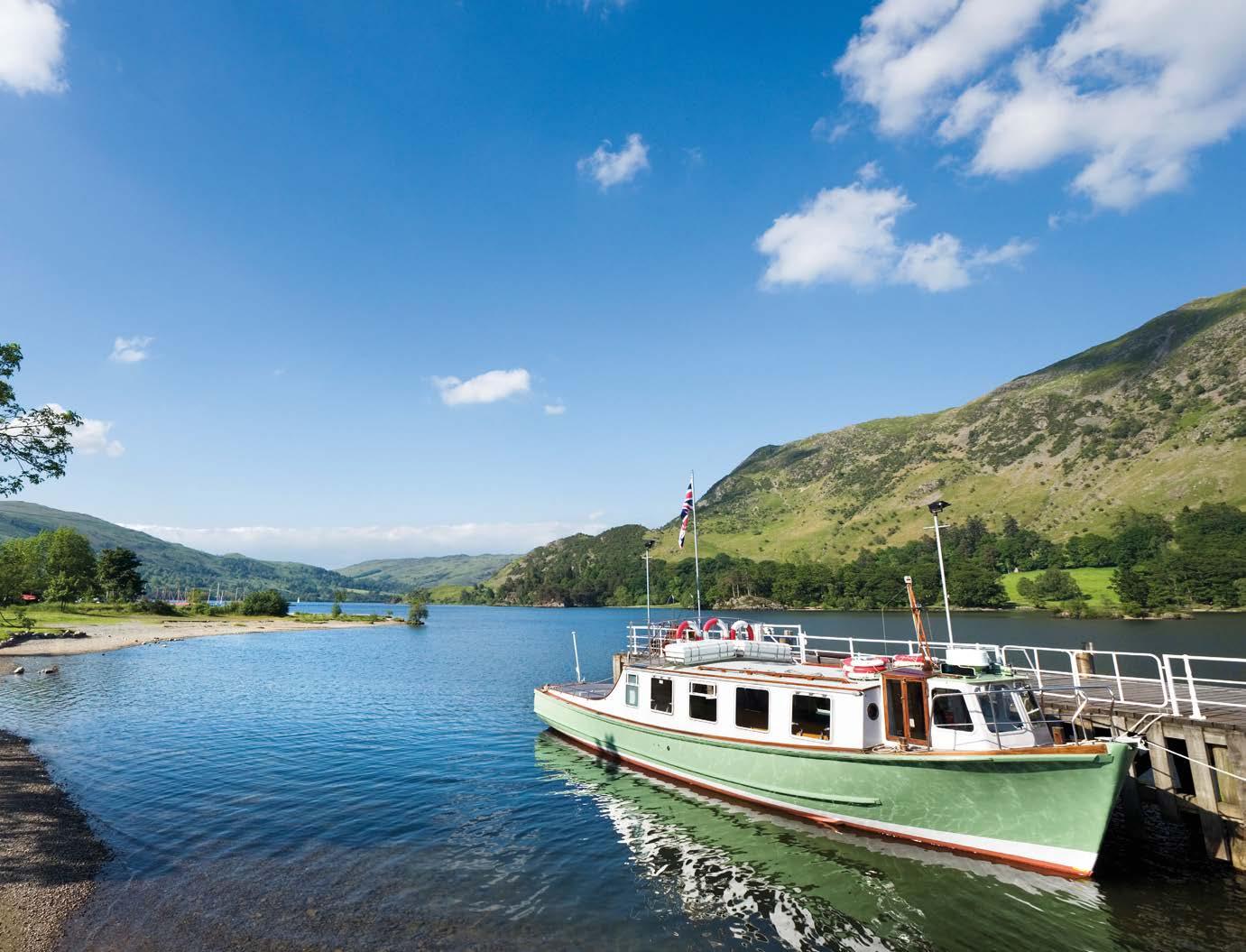
I wanted to see the lovely landscape in a leisurely, though not lazy, way...to step away from the everyday world for a while
that way. I wanted to see the lovely landscape in a leisurely, though not lazy, way. Which was why I had no Wainwrights in my rucksack. What I did have, packed mentally, was a desire to step away from the everyday world for a while – and, quite frankly, to enjoy myself.
This I thoroughly achieved. There was great pleasure to be had staying at a sequence of mainly cosy little inns and sometimes hostels or hotels, and on one chilly occasion near Shap, a remote bothy (deserted shepherd’s cottage). Walk hard round the fells, sticking to the shores of the lakes and the foothills wherever possible (so not too hard really), then relax by a roaring fire, if one was to be had. Ideally, with a foaming pint of ale from one of the region’s incredible number of little craft breweries.
This had, I (correctly) reasoned beforehand, the makings of a decent getaway. From Ullswater, I would proceed to Keswick and Derwentwater, head northwest
to Cockermouth via Lake Bassenthwaite, saunter south to Buttermere, Ennerdale and Wastwater, and continue via Coniston, Hawkshead, Windermere, Ambleside and Grasmere on a route that would eventually lead back to Penrith for the train home.
I had a pair of new boots (already slightly worn-in to avoid blisters). All those OS maps were packed. An emergency shelter (never required) bulged at the bottom of my rucksack. Waterproofs: tick, plenty of layers: tick, too. I did not bother with walking apps – I was going “old school”, leaving the land of small screens behind for a while.
No more than 15 miles a day was the plan – and I stuck to it as best I could. On one day, however, looping to Cartmel on a diversion, I covered 24. This was a big mistake. I had wanted to lunch at one of the Michelinstar restaurants run by the renowned chef Simon Rogan, which was indeed excellent, though pricey (around £100 for the set menu and a drink). The Lake District was in the middle of a fine-dining “culinary revolution”, I had been informed, and Rogan was at the heart of it all.
But 24 miles was too much. Much better to stick to eight or ten, or perhaps a handful extra. More relaxing
BRITAIN 35 www.britain-magazine.com


DAY 1
TAKE THE SEA AIR


A relaxing promenade along Brighton’s iconic Victorian seafront is an essential start to any visit to the city. Though it was once a small Saxon shing village, in the 18th century Dr Richard Russell, a physician and author of a treatise on the health bene ts of sea bathing, relocated his practice to Brighton’s seafront, marking the beginning of the transformation of the town into a fashionable seaside resort. In 1738, the future King George IV made the rst of many visits, cementing the town’s popularity amongst London’s high society, and it is his powerful patronage you can still see in Brighton’s Regency-style squares and terraces today (below left). Admire this elegant architecture as you walk along the seafront promenade, whilst soaking up the hustle and bustle of Brighton beach life.
HERE FOR THE PIER
An unmissable sight along Brighton’s seafront, Brighton Palace Pier (right) is a must for any visitor. While its predecessor sits in atmospheric ruin a little way along the shore, the iconic Palace Pier, which dates back to 1899, is an ode to the Victorian seaside, with all the 21st-century pleasures you could ask for. The 537m-long pleasure ground is packed with food stalls selling seaside treats like candy oss and sh and chips, and you can amuse yourself for hours at the arcade games and funfair, with classic rides from spinning teacups to a haunted house.
UNDER THE SEA
Located just a few metres from the pier, Brighton’s SEA LIFE (below right) is the oldest operating aquarium in the world, having rst opened its doors to curious Victorian visitors in 1872. Stroll through the aquarium’s beautifully restored Victorian arcade and admire over 5,000 different species of sea creature, from sharks and turtles to octopus and star sh. All the aquarium’s seawater tanks are fed from one large tank under the building which, in turn, is lled up by the sea itself as the tide ows in and out twice a day.
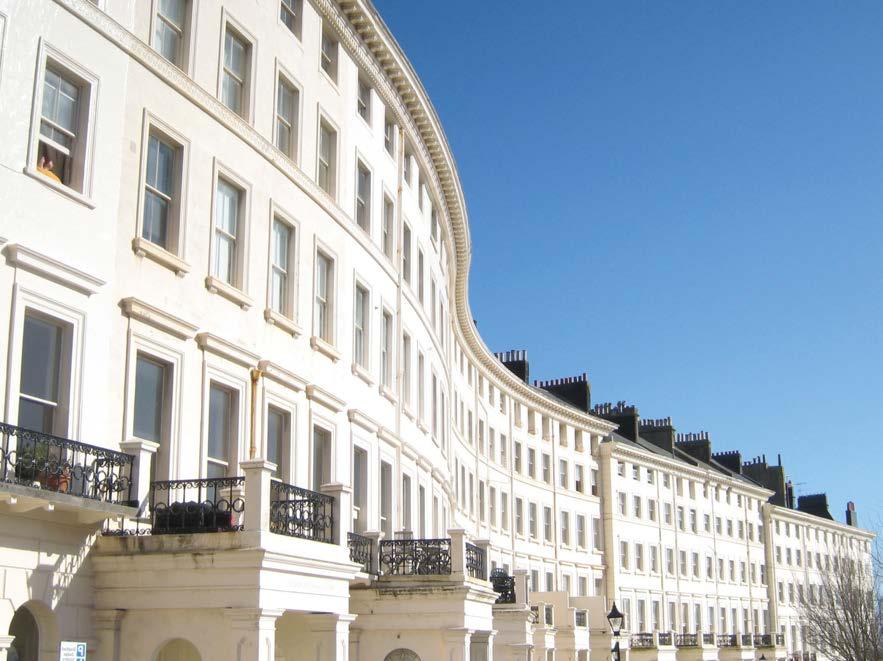

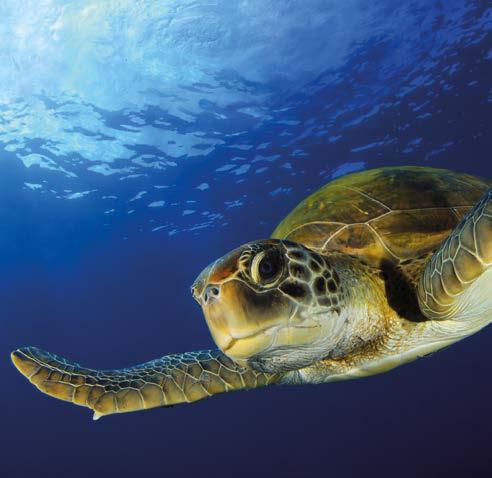
www.britain-magazine.com
76 BRITAIN



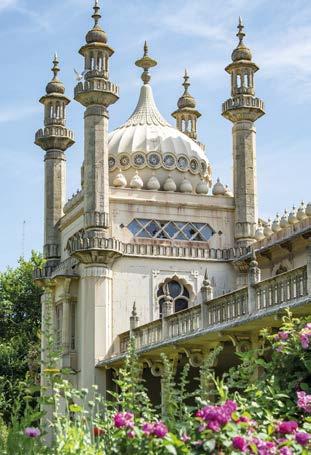
DAY 2
LOVE THE LANES
Start your second day with a morning exploring Brighton’s intriguing hodgepodge of cobbled lanes and higgledy-piggledy backstreets. The Lanes and North Laine area (left) are packed with independent shops, art galleries, cafés and many of the city’s best restaurants. Reflecting the city’s colourful personality, North Laine is closed to traffic at the weekends when it becomes the social hub of the city, with tables and chairs filling up the pavements and shop owners bringing their stock out into the street to sell their wares. Spend a morning hunting for vintage treasures, picking up quirky gifts or shopping for chic homeware, and soak up the atmosphere with some alfresco refreshments.
FIT FOR A KING
The Royal Pavilion (below left) was built as a pleasure palace for the extravagant Prince Regent, the future King George IV. In 1815 the prince hired architect John Nash to design this magnificent, Indian Mogul-style palace, with exotic Indianand Chinese-style interiors. Highlights include the theatrical domed Banqueting Room and the most important collection of Regency gilt silverware anywhere on public view.
NOSTALGIA AT THE MUSEUM
Brighton Museum & Art Gallery in the Royal Gardens houses a fantastic collection of galleries displaying 20th-century art and design, fine art and exhibitions exploring Brighton’s history of fashion and style. This summer, the museum is hosting a special exhibition celebrating ABBA’s visit to Brighton 50 years ago, when they won the Eurovision Song Contest with their hit song Waterloo (until 4 August).
DAY TRIPS
The chalky cliffs known as the Seven Sisters (below), one of England’s most spectacular sights, lie just a few miles east of Brighton. There’s a 13km stretch of coastal path to enjoy with a lovely selection of cafés and pubs along the way. The historic towns of Lewes and Arundel are also within easy reach.

TAKE 5 BRIGHTON EXPERIENCES
Go sky high
Enjoy unmatched panoramic views of Brighton’s skyline, and out to the South Downs, at the Brighton i360 moving observation tower on the seafront (top left).
Deal with the devil
Just five miles from the city centre, the Devil’s Dyke valley is a legendary beauty spot in the South Downs, offering panoramic views out to the city and the sea, and a suitably curious history too.
Swim free
Opened in 2023, Sea Lanes, a heated 50-metre outdoor swimming pool, offers stunning views of the historic seafront and Brighton’s iconic beach as you swim.
Admire the coast
The 5km-long Undercliff Walk is an uninterrupted path between Brighton and Saltdean underneath the chalky cliffs, and is a lovely way to enjoy Brighton’s pretty stretch of seaside.
Toast the trip
Sussex is home to some of the country’s best wine-producing vineyards. Stop in for a vineyard tour and a wine tasting at Ridgeview Wine Estate, just a few miles outside of the city.
BRITAIN 77 www.britain-magazine.com city guide
PHOTOS:
© ISTOCK/JACK PARKER PHOTOGRAPHY/STOCKINASIA/JOHN GILHAM/ VISIT BRIGHTON/DAVID CARBO/SHUTTERSTOCK/SIMON DACK
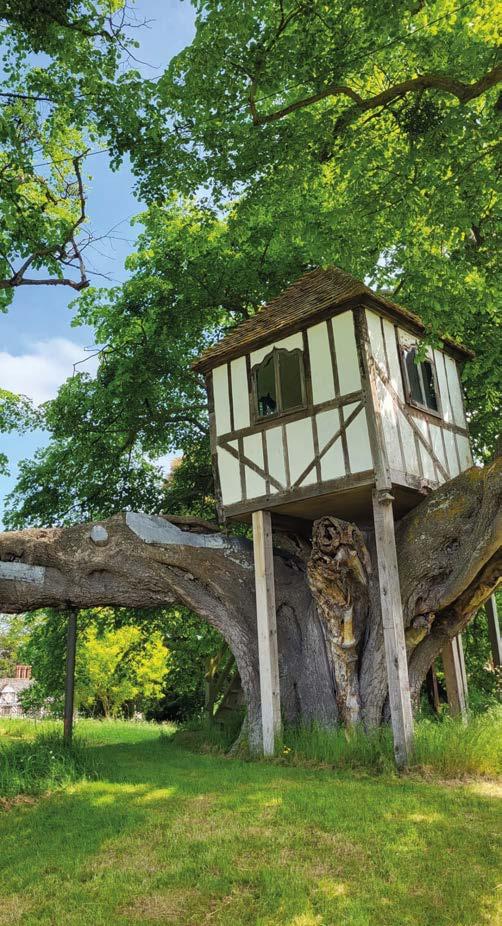
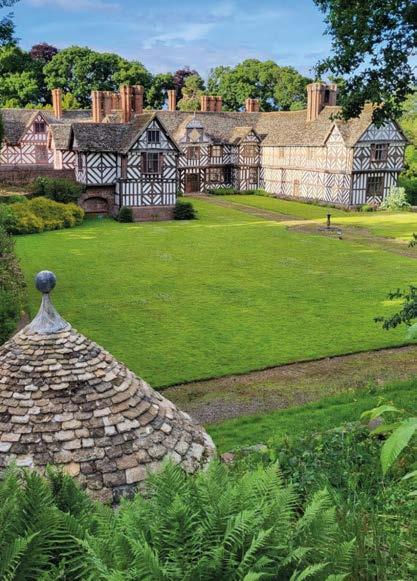


80 BRITAIN www.britain-magazine.com PHOTOS: © JAY WILLIAMS/GRAHAME MELLANBY











